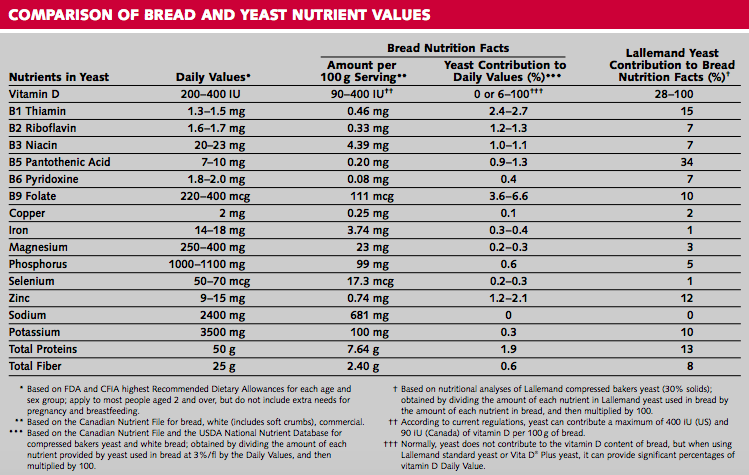
In baked goods, yeast has three main roles.
Leavening
The carbon dioxide gas produced by yeast expands the dough as it is trapped within the dough’s protein matrix. This stretching results in the light, airy structure associated with yeast-leavened products. The dough matures or develops through the action of fermentation on the gluten structure. Yeasts that are more tolerant and resilient are selected for high-stress processes. The availability of yeasts specifically selected for their ability to survive subzero temperatures has revolutionized the frozen and parbaked sectors.
As a result of no-time dough processing, volume-processed standard bread has lost bread’s characteristic fermentation flavor. Consequently, certain yeast suppliers have turned their attention to yeast strains that provide excellent and, more interestingly, variable flavor profiling in bread.
Flavor
Bread’s taste and aroma are the result of its ingredients, the aromas originating from the yeast’s fermentation, and the thermochemical reactions during baking. Yeast imparts the characteristic flavor of bread and other yeast-leavened products. Sugars are metabolized when yeast produces carbon dioxide. This produces a spectrum of intermediate metabolites, many of which are precursors for flavor.
Yeast fermentation products that can be detected both in dough and in the finished bread include ethanol and higher alcohols, aldehydes, and organic acids, which are by-products of the yeast’s primary metabolic function in dough. Some of these by-products enhance the rate of browning reactions and the formation of melanoids and caramels in the bread crust. Important substrates for these types of reactions are sugars and amino acids. By contributing some of these substrates, the yeast also influences the eventual taste and flavor of the bread.
Nutrition
The precise nutrient values of yeast can vary with manufacturer. This is why the Canadian Nutrient File and the USDA National Nutrient Database for Standard Reference have conjointly established the nutrient profile of compressed bakers yeast. The Nutrition Facts table on a baked product’s packaging shows the percentage of Daily Values that a bread serving can contribute.
When considering the Daily Values for different nutrients versus the nutrients provided by compressed bakers yeast used in bread at 3%/fl, except for vitamin D and folate, yeast only contributes small percentages. However, when comparing the amount of nutrients found in bread with that provided by yeast, it is clear that bakers yeast significantly contributes to bread’s nutritional value.

The nutritional and health benefits of yeast
Yeast can naturally contribute significant amounts of numerous nutrients to bread and baked goods.
Vitamin D
Phytosterols are natural plant sterols that have been shown to effectively lower blood cholesterol, enhance the immune system, and decrease the risk of certain cancers. The lowering of cholesterol is phytosterol’s most documented health property. When exposed to UV light, ergosterol is converted to vitamin D.
Apart from the prevention of the deficiency diseases rickets and osteomalacia, vitamin D is involved in maintaining calcium balance in the body, normal cell division and immune system function, a healthy inflammatory response, and normal muscle function. Bakers yeast typically contains 0.5 percent (w/w) ergosterol, but selected strains can contain up to 1.5 percent ergosterol. The vitamin D level in yeast can be adjusted to any needs.
B vitamins
Soluble in water, the B vitamins found in yeast are structurally dissimilar yet equally essential for normal cellular functions, growth, and development.
- Thiamin (B1) acts as a coenzyme in a variety of critical metabolic reactions related to energy metabolism. B1 deficiency can lead to a variety of clinical abnormalities, including neurological and cardiovascular (heart failure) disorders.
- Niacin (B3) is involved in glucose and fatty acid oxidation. It is one of the five vitamins that when lacking in human diet is associated with a pandemic deficiency disease called pellagra, which causes diarrhea, dermatitis, and dementia.
- Pantothenic acid (B5) is involved in fatty acid synthesis and degradation as well as in the synthesis of cholesterol, steroid hormones, heme, and acetylcholine. B5-deficiency symptoms are similar to those of other vitamin B deficiencies. Impaired energy production, due to low CoA levels, could cause irritability, fatigue, and apathy.
- Folate (B9) has a well-established role in the prevention of neurotubular birth defect (spina bifida). It also has a possible preventative role against cardiovascular disease, certain cancers, and neuropsychiatric conditions.
Minerals
The minerals found in yeast are involved in growth, development, energy metabolism, and the reproductive system.
- Potassium acts as an osmotic pressure regulator and is involved in the body acid–base balance and muscle contraction. Epidemiological studies indicate that diets high in potassium can reduce the of hypertension and possibly stroke.
- Zinc is an important constituent of insulin and the DNA and RNA repair/enzyme function. It is involved in flavor perception and acts as vitamin A carrier. Symptoms of zinc deficiency include depressed growth, diarrhea, impotence and delayed sexual maturation, alopecia, and eye and skin lesions.
Proteins
Proteins are the chief actors within the cell, said to be carrying out the duties specified by the information encoded in genes. The best-known role of proteins in the cell is as enzymes, which catalyze chemical reactions. Proteins have recently been recognized for their role in weight management and satiety. They represent more than 50 percent of yeast (w/w).
Dietary fibers
Dietary fibers play a role in maintaining normal intestinal function and stimulating the immune system. They are also known to act as prebiotic, improve insulin resistance, and reduce serum cholesterol. Yeast typically contains 30 to 40 percent (dry weight) fibers, of which 60% are beta-glucans.
- Beta-glucans, polysaccharides found in yeast cell walls, have been shown to reduce blood cholesterol concentrations. Reports have also been published on the immune benefits of yeast (Saccharomyces cerevisiae) beta-glucans.

